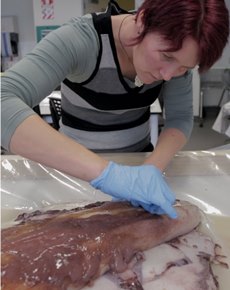Giant squid dissection held at AUT University

AUT researchers got up close and personal with not one, but three giant squids yesterday.
Marine Biologist and AUT lecturer Dr Kat Bolstad led a team of post-graduate students and AUT University academics in the examination and dissection of the Architeuthis dux specimens which were found in New Zealand waters.
Giant squids have long fascinated mankind, but many aspects of their biology remain poorly understood. Dr Bolstad and her team set out to shed some light on the lives of these mysterious creatures through the data collected during the dissection.
The information collected will help establish how the giant squid fits into marine food webs, possible effects of ocean acidification on this species, its genetic information and the vision of giant squids.
The University hosted the dissection online via live streaming, and the following demonstrates just how much these fascinating creatures capture the imagination of the public. The Giant Squid Enthusiasts corner of Twitterverse held a mini party aptly named a cephaloparty (check out the images here), and Twitter was abuzz with excitement (#AUTsquid) as viewers tuned in from all over the world. Questions were also submitted live from viewers and answered in live chat with the team.
The giant squid specimens examined were donated to AUT’s Institute for Applied Ecology New Zealand by NIWA’s Invertebrate Collections and the Scientific Observer Programme, who were enthusiastic to see then made available for scientific investigation.
If you missed out on the live stream, keep a look out for an upcoming video – we’ll be bringing you some of the highlights soon
Giant Squid FAQ
How big does it get?
Architeuthis appears to attain a maximum mantle length of about 2.25m (7.4 feet), or a total length of 13m (42 feet); the largest specimens known to date have been females, and males appear to reach slightly smaller maximum sizes.
What does it eat?
Giant squid appear to eat relatively small prey (generally smaller than 60cm) including fish, crustaceans and other squid.
How smart is it?
Sadly, the answer to this question is probably “not very.” While octopuses are very intelligent, perhaps on a level with some parrot species, a giant squid weighing 220kg has about a 20g brain, of which about 2/3 is dedicated to visual control and processing. These animals are quite interesting… but not (as far as we know so far) for any extreme intelligence.
Is it edible?
Giant squid are not palatable to humans—their tissues are full of ammonium. So far they appear most tasty to sperm whales.
After being examined, the best specimen will be preserved and prepared for display at Auckland Museum. The remaining specimens will be sampled to gain as much information about the giant squid as possible, and parts of them saved for display and educational purposes.